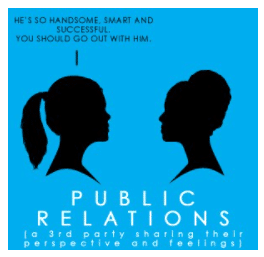When explaining PR versus Marketing, I’ve always found it helpful to use this analogy (and most of us can all relate to dating!).
If a man tells a woman she’s intelligent, looks lovely, and is a great conversationalist, he’s saying the right things to the right person to influence her decision to date him and make her feel a certain way. That’s Marketing.
If someone else (like a friend or relative that) tells the woman how handsome, smart, and successful he is, it influences her decision to date him and makes her feel a certain way. That’s PR.
Dating example aside, here’s another analogy:,
“When you see a company on a billboard, that’s Marketing. When you read about a company in a newspaper, magazine, or online blog (and it’s not sponsored!) – that’s public relations.”
Can you see the difference? Marketing is paid for, or called “owned” because the company “owns” the messaging. PR is earned because the company “earns” the coverage.
Before we dig even further into what each means, let’s break it down by function.
What is Public Relations (PR)?
PR is a function and subset within Marketing that uses strategic messaging and different non-paid media channels (we’ll get more into that below) to create, maintain, or improve a company’s reputation, relationships, and brand image with the “public.” The “public” can be defined as parties that you do not do business with, but are important for your company. Think: community, media, employees, investors, etc. Public relations professionals work closely and in tandem with the other Marketing functions.
An important side note is that PR is sometimes referred to as “Media Relations”. This is because a major role of PR is to interact with journalists and editors to reactively respond to media outlets and proactively place stories that help enhance credibility or authority, crisis management, improve the public’s perception of your business, sell products, or accomplish the company’s goals..
With that information in mind, consider PR as just one (yet an incredibly important) tool in your Marketing tool belt, to get your messages across to influential audiences.
I want to dive in deeper with PR, and outline some of the characteristics and qualities of what PR teams specifically do, to help bring clarity about its function and purpose.
Messaging and Audience
In a nutshell, one of the most important functions of a PR professional is to relay the right messages, to the right people. Read: take the news announcement and make sure that it gets in front of the right audience (wherever they are consuming their information).
Depending upon your business objectives, your audience will vary greatly. For instance, if you are selling a tech product, your audience may be tech reporters. If you are working with a government agency, you will have a strong focus on government relations. You also might focus on investors, the community, developers (if you are hiring) and of course, the media.
While Marketing may also touch upon some of these audiences, the intent and objective is different; PR is designed to influence an audience’s perception and opinion (read: reputation), whereas Marketing is a variety of tactics designed to push the “owned” message to influence buyers (read: drive sales). Your PR strategy will always depend (and differ) depending upon the audience you want to reach.
With your audience in mind, PR professionals then have to determine how they want to reach these different audiences. If you think of your audience and break it down in an incredibly simplistic way, think of how your channel (the mode in which you communicate) would vary from trying to reach a teen versus an elder. If you wanted to reach a teenager, would you pitch your news to AARP? Furthermore, if you have a new wine label you’re launching, would you pitch it to Bloomberg? When it comes to PR, you go where your audience is that you want to reach.
Channels of Communication
Given that PR is the specific field of placing or influencing non-paid external communications (paid communications would be tactics like digital advertising, direct mail, etc.), the channels in how you reach your audience can vary greatly depending on how they consume their information and the goals in which you must meet—like brand awareness and improving public opinion.
Public relations channels include:
- Press releases and media coverage
- Media alerts
- Interviews with media
- Speaking engagements at in-person or virtual events or trade shows, podcasts
- Thought leadership pieces, including contributed articles in business press or trade publications
- Placements of testimonials or customer/case stories
Now that you know about PR, what about Marketing?
Marketing is all about control and ownership. When it comes to controlling the message, Marketing is focused on tactics that can be controlled: owned and paid channels. Think of it like the copy for your website, blog, newsletter, or social media promotions. You own that content.
Whereas, PR is earned, meaning that it refers to media exposure you’ve earned through outreach and talking to reporters. It is getting OTHER people to tell your story, whether that is a journalist, an influencer, or somebody else’s social media.
With Marketing, you can directly control your content which means you can directly control your message to target audiences . With PR, you control your message and who you pitch it to, but it’s ultimately up to the journalist or influencer on how they tell your story. And, hopefully the timing is right, they have interest, there are no conflicting events, etc. There is an art to pitching a story.
Measuring PR vs. Marketing
While the two roles have alignment, they have very different measurable objectives. Marketing aligns with sales generation, while PR aligns with lead generation. They have different measurable goals. Because Marketing is a sales generation tool—you can easily measure return on investment (ROI) of your marketing activities. PR is responsible for reputation and more nuanced—you can lead a horse to water (i..e, the reporter), but you can’t make it drink. While PR won’t directly affect the bottom line in the short-term, it can lead to more brand awareness and your marketing team can target new audiences to improve sales.
Channels of Communication
A Marketing channel is defined as any platform that is used to communicate with your target audience that you own. Differing from PR, you control the messaging on the platform—including what and when you publish. Just like PR, Marketing channels all have a different value, purpose, and experience associated with them. Here are some of the most well-known and most used Marketing channels.
- Social media platforms like Facebook, Twitter, Instagram, Clubhouse, and more
- Email marketing
- Website
- Content marketing (this can also include podcast and video marketing)
- Search engine optimization (SEO)
- Pay-per-click (PPC), also called search advertising
- Display ads
How can PR and Marketing successfully play together?
Marketing helps target and amplify the message, while PR helps to reinforce the message and bring credibility to it.
PR lends a level of authority and credibility that Marketing doesn’t. And trust, authority, and credibility helps you grow your business.
Think about when you book a hotel for a trip. Do you trust the ad telling you about the amenities and experience, or do you go to TripAdvisor and read what other guests had to say? As a human, you’re already naturally looking for third party validation of the ad that’s marketing to you. When coupled together, PR and Marketing can be an incredibly strong tool to reach your targeted buyers and ultimately convert them into customers.
When a journalist writes a story, they are giving their stamp of approval and building a positive reputation for your business. A good piece of press coverage has the ability to drive thousands, if not millions of people back to your website. And that traffic could convert into new customers – especially if it promotes new products or a specific product
Think about when you’re trying to sell your product or offering to a new client, imagine the credibility when you’re able to say “Forbes wrote about us, see what they had to say in this piece,” as you send the link or slide the article their way. Now compare that with saying “Our CEO wrote about us, see what he or she had to say.” The reaction will be quite different.
I once placed a client on the cover of Fast Company. The article generated so many leads, that the company’s website CRASHED due to traffic! How many times can your advertisement do that?
Conclusion
In closing, as part of the overall Marketing mix, PR helps build brand equity and should be looked at as another function—an investment—to help promote the brand. When done correctly, PR has the ability to grow your business and its credibility like no other medium.
Read more PR tips, tricks and thoughts at RemotePRJobs.com, the #1 jobs resource for PR and Communications professionals. It’s a weekly newsletter and website membership that shares 30+ remote PR and Communications jobs every week. Jobs are project-based, part-time and full-time, across a variety of industries.


